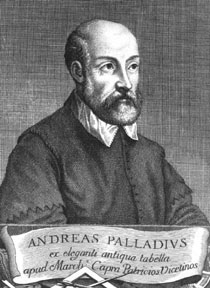Biography

Andrea Palladio was born in 1508 in Padua. When he was only 13 years old, he was apprenticed as a stonecutter in his little town. However, Palladio wasn't happy with the job, so he broke the contract after 18 months of apprenticeship and then moved to Vicenza. There, he became an assistant in a shop with stonecutters/masons. He eventually became very skilled under his mentor, Gian Giorgio Trissino, who actually changed Andrea's last name to the the name we know him for (His original name was Andrea di Pietro della Gondola). Under Trissino, Palladio learned a lot about classical architecture and many other disciplines of the Renaissance education. He studied many books, eventually studying the principles of Vitruvius and Leon Battista Alberti, both of whom lived during Classical Rome. In 1538, Palladio began working on one of a series of country villas, the Villa Godi. About a decade after this, Palladio began getting commissions from the wealthy landowners and nobility of venice, and finally, in 1560, he recieved his first commission for a work right in Venice itself, a completion of the refectory for the Benedictine monastery of San Giorgio Maggiore. After this, many other commissions for the building of religous structures followed. Although he was very popular, he never actually recieved any secular commissions in Venice.
The first book that Palladio published was merely a guide to the ancient structures in Ancient Rome, mainly because of the frustration he faced when trying to find monuments on his own in Rome. After this book, he published a new translation of Caesar's Commentaries. Then, in 1570, he published the book that landed him his fame for Renaissance architecture: Quattro Libri dell' Architettura [The Four Books of Architecture]. This book is widely known for the detailed diagrams of Palladio's architectural style, including one feature he is known for: the palladian window.
Like most famous people, Palladio eventually died in his adopted hometown of Vicenza in 1580.
Sources:
Photograph: -http://en.structurae.de/files/photos/r0001290/palladio02.jpg
-http://farm1.static.flickr.com/109/285574110_124d7c7bd2.jpg?v=0
Information: -http://www.boglewood.com/palladio/life.html
-http://en.wikipedia.org/wiki/Andrea_Palladio
-http://architecture.about.com/od/greatarchitects/p/palladio.htm
-http://ville.inews.it/epallad.htm
Page created by Randa McGuire
